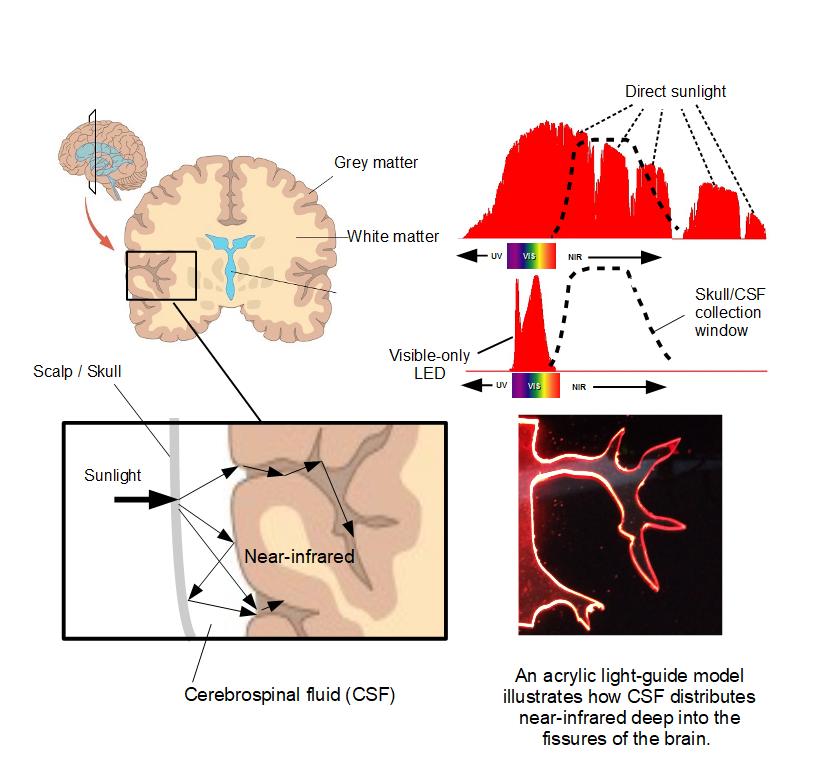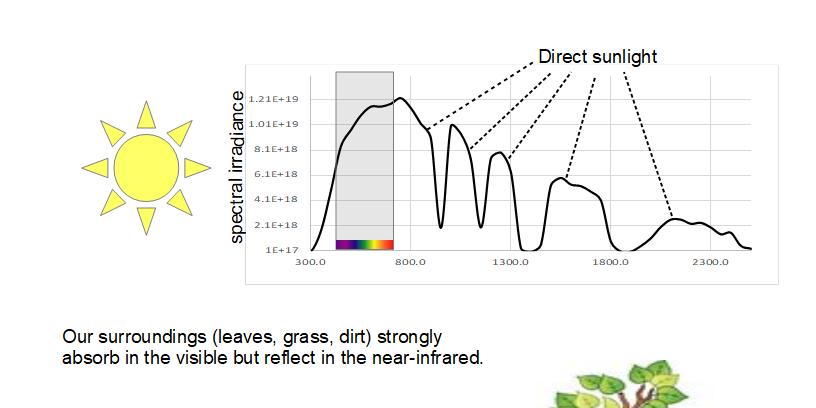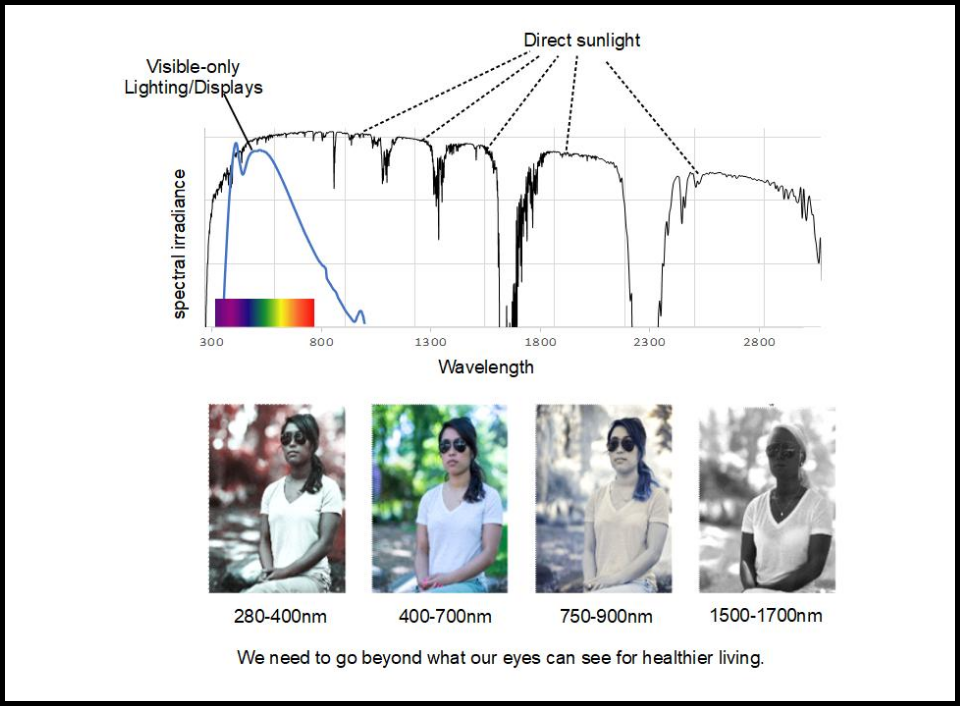Our bodies were designed to benefit from natural sunlight.
Over the last century, when we evolved from the incandescent bulb to fluorescents and LEDs, we focused on lighting spaces instead of light’s interaction with the human body. The invisible near-infrared spectrum that is present in natural sunlight was absent from these energy-efficient bulbs. LEDs only included the visible light spectrum, as the positive health benefits of near-infrared energy were largely unknown at the time. An unintended consequence developed: emerging research suggests that lack of certain sunlight characteristics could be linked to health problems.
The body assumes we are exposed to a single, predominantly near-infrared emitter:the sun. In nature we are never exposed to UV/Visible photons without an excess of near- infrared.
As creating healthier spaces becomes the driving force behind innovation and marketing, the lighting and architecture industries should re-introduce the invisible portions of the solar spectrum that we removed from our homes, offices and schools. One only has to model the eye, brain, womb, and skin to quickly realize that the body has gone to great lengths to collect and localize, in our most sensitive tissues, the portions of the solar spectrum we eliminated. Current LED lighting/displays and UV/near-infrared blocking coatings on our windows counteract nature. They increase the oxidative stress on our cells because they do not stimulate protective bio-optical responses of sunlight.
The elephant in the room is literally invisible!
Sunlight used to represent the single largest energy input to the human body. However, as shown in the figure below, visible-only LED lighting, which is devoid of beneficial, invisible near-infrared energy, has eliminated that part of the solar spectrum from our homes, offices, and schools. This void is compounded by the fact that we spend about 90% of our time indoors.

Why is that significant? Our bodies use invisible near-infrared energy from natural sunlight to repair(1), protect(1) and detox(2) our cells. Unlike UV and visible light, near-infrared energy penetrates more than an inch beneath our skin’s surface to reach the most critical tissues (e.g. retinas, gray matter, blood vessels, fetuses).
Research continues to uncover ways in which sunlight interacts with the human body, as well as animals and plants. Findings reveal a host of previously undiscovered optical mechanisms that show we have evolved to use the entire solar spectrum, not just what we see with our eyes.
In fact, the fluid surrounding the brain acts as a light guide in the near-infrared, ensuring distribution of energy deep into the brain. Similar optical effects have been shown to occur in the eye, womb and skin. Research validates that brain and eye development of the fetus benefit from exposure to near-infrared energy (3,4) .

As children’s eyes continue to develop until about age 13, regular exposure to natural sunlight helps their eyeballs form properly to reduce the risk of developing myopia (nearsightedness) [5,6], which is now reaching epidemic proportions worldwide (7).
In addition, studies have shown that students studying under natural light perform better than students studying under artificial lights (fluorescent or LED) [8,9].
When near-infrared energy is absorbed by our bodies, it prompts the release of nitric oxide compounds that increase blood flow and remove toxic waste (10,2) . Our bodies also convert near-infrared energy into other energy, adenosine triphosphate11 (ATP), which our cells need to thrive (12) .


Without question, our bodies need near-infrared energy, and we don’t spend enough time outdoors to absorb the amount we need.
Blue light: friend or foe?
Blue light overexposure has come to the forefront as our homes, offices and schools converted to visible-only LED lighting and we increased our use of electronic devices (smartphones, tablets, computers).
Let’s be clear. Blue light can be beneficial. During the day, blue light (in all natural and artificial lighting) helps boost alertness as well as increase memory and cognitive function. However, exposure to blue-only light without the rest of the solar spectrum can damage our eyes’ retinal cells (2,13).
The sun provides blue light, however, it is never present without near-infrared energy also being emitted.
Combating sleep disruption
We didn’t have a circadian rhythm (14) problem when our homes were being lit by incandescent bulbs and we spent more time outside. Ads for sleeping pills and a plethora of melatonin and other supplements were nowhere near as prevalent as they are today.
The answer to problems falling asleep may not be found in a bottle, but rather in a bulb.
Blue light overexposure from visible-only LEDs has become a key reason for sleep disruption (15,16). At night, too much blue light interrupts our circadian rhythm by suppressing the production of melatonin, making it difficult to fall asleep. Consequently, researchers recommend reducing blue light exposure for at least an hour before bedtime (17).
In an effort to alleviate this problem the industry has developed color-changing, visible-only LED lights. Their drawback? They lack near-infrared energy, which may help to regulate your circadian rhythm and support less disrupted sleep (17).
As near-infrared energy uniquely penetrates deep into the skin, it stimulates the release of nitric oxide compounds. This increases blood flow and antioxidants as needed (10).
It has long been known that nitric oxide accumulation in portions of the brain is a required element to enter REM sleep. The quality of sleep is not just a matter of less blue light (18).
Bring back the invisible

The industry has created a “full-spectrum” LED market segment that purports to deliver what the name implies. The issue is that these lights contain only the full visible spectrum, without the invisible spectrum that comprises the majority of sunlight. A bulb simply cannot resemble or mimic the sun without containing near-infrared.
More than 4,000 peer-reviewed medical journal articles have highlighted how near-infrared is used by our bodies to stimulate repair (21) in our cells, along with a host of other functions. This underscores the need for lighting that more accurately represents sunlight. We as an industry have the opportunity to impact health in a positive way, however, it requires more than visible-only lighting. We need to re-introduce the invisible spectrum into the equation. We need to advocate for research on lighting and its effects on the human body, plants and animals that includes the near-infrared spectrum, not solely visible light.
This article was originally featured in the August issue of designing lighting (dl)
References
[1] Warburg, Otto. “The oxygen-transferring ferment of respiration.” Nobel Prize, Nobel lecture, Dec. 10, 1931, www.nobelprize.org/prizes/medicine/1931/warburg/ lecture/.
[2] Jaminet, Paul, PhD. “The Benefits of Near Infrared Light.” Perfect Health Diet, June 9, 2015, www.perfecthealthdiet.com/2015/06/the-benefits-of-nearinfrared-light/.
[3] Bardi, Jason. “Light Exposure During Pregnancy Key to Normal Eye Development.” University of California San Francisco (UCSF), January 16, 2013, www.ucsf.edu/ news/2013/01/13399/light-exposure-during-pregnancykey-normal-eye-development.
[4] Steigman, Shaun A., Kunisaki, Shaun M., WilkinsHaug, Louise, Takoudes, Tamara C., and Fauza, Dario O. “Optical properties of human amniotic fluid: implications for videofetoscopic surgery.” PubMed (National Library of Medicine, National Center for Biotechnology Information), Fetal Diagn Ther. 2010;27(2):87-90. doi: 10.1159/000262279. Epub 2009 Nov 25. PMID: 19940448. www.pubmed.ncbi.nlm.nih.gov/19940448/.
[5] University of Sydney. “Eyes on the sun: Child sunshine exposure and eye development.” Medical Xpress, May 21, 2013, www.medicalxpress.com/news/2013-05-eyessun-child-sunshine-exposure.html.
[6] He, Mingguang, MD, PhD; Xiang, Fan, MD, PhD; Zeng, Yangfa, MD; et al. “Effect of Time Spent Outdoors at School on the Development of Myopia Among Children in China.” JAMA Network, September 15, 2015, www. jamanetwork.com/journals/jama/fullarticle/2441261.
[7] Mehta, Neesurg, MD, Wen, Angie, MD. “Myopia: A Global Epidemic.” Retina Today, September 2019, www. retinatoday.com/articles/2019-sept/myopia-a-globalepidemic.
[8] Mirrahimi, Seyedehzahra, Lukman, Nik, Ibrahim, Nik, and Surat, M. “Effect of daylighting on student health and performance.” 2013, wseas.us/e-library/ conferences/2013/Malaysia/MACMESE/MACMESE-20.pdf
[9] Cooper, Kenneth J. “Study Says Natural Classroom Lighting Can Aid Achievement.” The Washington Post, November 26, 1999, www.washingtonpost.com/archive/ politics/1999/11/26/study-says-natural-classroomlighting-can-aid-achievement/776b9d19-05e8-417a8591-3053063ad8be/.
[10] Keszler, Agnes, Lindemer, Brian, Weihrauch, Dorothee, Jones, Deron, Hogg, Neil, and Lohr, Nicole L. “Red/near infrared light stimulates release of an endothelium dependent vasodilator and rescues vascular dysfunction in a diabetes model.” PubMed (National Library of Medicine, National Center for Biotechnology Information), [published correction appears in Free Radic Biol Med. 2019 Feb 1;131:443]. Free Radic Biol Med, Dec. 2017;113:157-164. doi:10.1016/j.freeradbiomed.2017, www.pubmed.ncbi. nlm.nih.gov/28935419/. [11] Helmenstine, Anne Marie, Ph.D. “What You Need To Know About Adenosine Triphosphate or ATP.” ThoughtCo., Aug. 26, 2020, www.thoughtco.com/atpimportant-molecule-in-metabolism-4050962.
[12] Reiter, Russel J. and Zimmerman, Scott. “Melatonin and the Optics of the Human Body.” Melatonin Research, February 21, 2019, www.melatonin-research.net/index. php/MR/article/download/19/208?inline=1.
[13] Heinig, Nora, Schumann, Ulrike, Calzia, Daniela, Panfoli, Isabella, Ader, Marius, Schmidt, Mirko H. H., Funk, Richard H. W., and Roehlecke, Cora. “Photobiomodulation Mediates Neuroprotection against Blue Light Induced Retinal Photoreceptor Degeneration.” ResearchGate, March 30, 2020, www.researchgate.net/ publication/340299256_Photobiomodulation_Mediates_ Neuroprotection_against_Blue_Light_Induced_Retinal_ Photoreceptor_Degeneration.
[14] National Institute of General Medical Services, National Institute of Health. “Circadian Rhythms.” NIGMS.NIH, www.nigms.nih.gov/education/fact-sheets/ Pages/circadian-rhythms.aspx. Accessed Oct. 29, 2020.
[15] Milone, F. Ferro, Bolner, A., Nordera, G. P., and Scalinci, S.Z. “Pulsed Led’s Light at 650 nm Promote and at 470 nm Suppress Melatonin’s Secretion.” SCIRP (Scientific Research Publishing), Mar. 20, 2015, www.file. scirp.org/pdf/NM_2015032015024664.pdf.
[16] Harvard Health Publishing, Harvard Medical School. “Blue light has a dark side.” Health.Harvard, May 2012 (updated July 7, 2020), www.health.harvard.edu/stayinghealthy/blue-light-has-a-dark-side.
[17] University of Haifa. “Blue light emitted by screens damages our sleep, study suggests.” Science Daily, August 22, 2017, www.sciencedaily.com/ releases/2017/08/170822103434.htm.
[18] Kalinchuk, A. V., Lu, Y., Stenberg, D., Rosenberg, P. A., Porkka-Heiskanen, T. “Nitric oxide production in the basal forebrain is required for recovery sleep.” Journal of Neurochemistry, Wiley Online Library, August 21, 2006, https://onlinelibrary.wiley.com/doi/full/10.1111/j.14714159.2006.04077.x.




